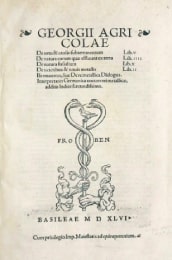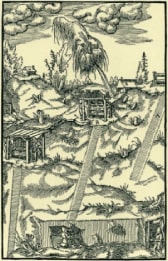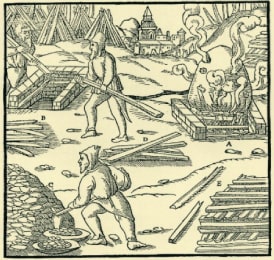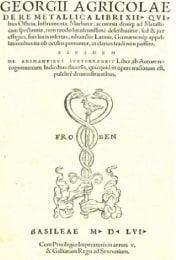Georgius Agricola
Georgius Agricola (1494–1555) – born as Georg Bauer, was a German scholar, humanist, mineralogist and metallurgist. He was born in the small town of Glauchau, in the Saska district of the Holy Roman Empire, he was broadly educated but was most interested in the mining and processing of metals. In his publications De Natura Fossilium (1546) and De Re Metallica (1556), Agricola opened the door to the systematic study of the Earth and its rocks, minerals and fossils.
De Re Metallica (1556) – Truly an original and valuable work that discusses everything known about mining in the first half of the sixteenth century. De Re Metallica, literally translated, means "On the Nature of Metals," but the word metal at that time had a broader meaning and referred to any mineral. In the 12 volumes of this work, Agricola provided an overview of practical methods for locating ores, exploration and mining techniques, ore analysis, the types and use of mining machinery, mine management, and much more. De Re Metallica was the first book on mining based on field research and observation, the first to use detailed illustrations to show specialized mining methods, and the first to provide a realistic history of mining from antiquity to the mid-sixteenth century. In it, Georgius Agricola moved mining from the realm of superstition and fantasy to its rightful place as an industrial science.
De Natura Fossilium (1546) – This book is not limited to what we today call fossils: the Latin word fossilis referred to anything dug up from the earth, and Agricola's book included, in addition to what we would now call fossils, descriptions of all kinds of minerals and gemstones. Agricola’s work summarized what ancient Greek and Roman authors had written about minerals and included a list of one hundred ancient authors whose works Agricola had read. Agricola was not afraid to contradict the opinions of the ancients if they did not align with his own experiences. His work represented a major advancement over previous writings about rocks and minerals because he classified them not alphabetically or according to their alleged mystical powers, but according to simple physical properties: "Thus, minerals have differences that we observe according to colour, taste, smell, place of origin, natural strength and weakness, shape, and size." Agricola gave standardized names to various minerals, not only noting their appearance but also the locations where they could be found. He also observed how the same minerals from different locations could have different colours and appearances. De Natura Fossilium was the first systematic mineralogy study.
Georgius Agricola



De re metallica, 1556 (On the Nature of Metals) – Agricola's book dedicated to mining and metallurgy – the cover page and pages from the book that show a medieval mine and how ores were smelted

The cover of the book De Natura Fossilium, 1546. – the first systematic publication in the field of mineralogy, in which Agricola classifies the minerals and describes their physical properties. The term fossilium was at that time used to denote any object dug up from the Earth (unlike its current meaning: every evidence of life from the geological past).